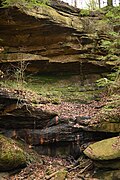| Natural Bridge Park | |
|---|---|
 Natural arches at the Park. | |
 Interactive map of Natural Bridge Park | |
| Location | Winston County, Alabama |
| Nearest town | Natural Bridge, Alabama |
| Coordinates | 34°05′35″N87°36′53″W / 34.09306°N 87.61472°W |
| Opened | 1954 |
| Owned by | Donnie and Naomi Lowman |
| Operated by | Donnie and Naomi Lowman |
| Status | open |
| Hiking trails | 2 mile nature path |
Natural Bridge Park, near the town of Natural Bridge, Alabama, is a privately owned park in Winston County that has been open since 1954. [1] [2] [3] The current owners are Donnie and Naomi Lowman. [4]
Contents
The Park's primary attraction is a natural-arch rock formation that is 60 feet (18 m) high, 148 feet (45 m) long, and composed of sandstone and iron ore. [1] [2] [5] The bridge is purported to be the longest natural arch east of the Rocky Mountains in North America. A two-mile nature trail guides visitors beneath the arch and past nearby rock formations. [6] Walking across the bridge itself is not permitted, due to safety concerns.
The Park includes picnic accommodations, an artesian well that supplies drinking fountains, a gift shop featuring hand-crafted items, 27 varieties of fern, and a stand of eastern hemlock (Tsuga canadensis)—a species that dates back to the Pleistocene epoch (approximately 2,580,000 to 11,700 years ago). [3]
Downhill from the arch is an outcropping of rock resembling a Native American head in right profile, similar to that of an old U.S. "Indian head" nickel. The stone formation is just over 15 feet (4.6 m) high.
- Indian head nickel.
- Stone formation.
As of 2024, the park is open from 8:00 am until 4:00 pm seven days a week and admission is $10.00 for adults. [4]










